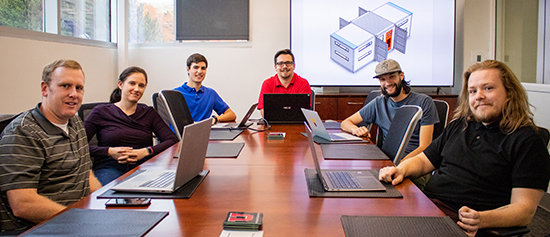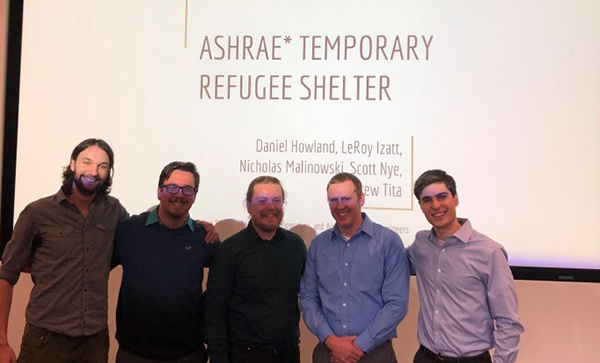Tasked with finding an engineering solution for building refugee shelters as needed throughout the world by ASHRAE, a global society advancing human well-being through sustainable technology for the built environment, mechanical engineering assistant professor Amanda Smith, advised seniors Daniel Howland, LeRoy Izatt, Nicholas Malinowski (team lead), Scott Nye, and Andrew Tita, and took 3rd Place in the world-wide undergraduate 2018 Setty Family Foundation Applied Engineering Challenge. Their award will be presented to them in Atlanta Georgia during the 2019 ASHRAE Winter Meeting, January 12-16, 2019. The team is co-advised by Ph.D. candidate Zahra Fallahi Arezoudar and Indiana Tech University mechanical engineering assistant professor Thomas Tran (U ME EN Ph.D. 2018).
The University of Utah team will present their capstone project at this semester’s December 4, Design Day, held in the Union Ballroom 10:00 am – 3:00 pm.
According to CARE.org, every minute of every day, 24 people around the world are forced to flee their homes. That’s 34,000 people per day who leave everything behind in the hope of finding safety and a better future. While it currently might not have a large impact on Utah’s mainstream, thinking through functional shelters could be a useful stepping stone to creating temporary housing in the event of a large natural disaster, such as an earthquake that has been anticipated to occur along the Wasatch Front. In that scenario, it would be critical to find and setup shelters for the many displaced families in stressful conditions.
U team member Andrew Tita said, “A few of the obstacles that our group dealt with was finding the balance between structural sturdiness, using the entirety of the allotted space, and transportability. We wanted a structure that was sturdy to prevent failure due to inclement weather while still using as much space as possible of the 260 square feet given to us while keeping the shelter transportable. This was a unique problem that took our group time to sort out the best possible solution.”
“We are learning a lot about the realities of the design process,” added Dan Howland. “It is one thing to learn engineering principles in the classroom, but it is something else altogether to apply those principles to a design problem. In addition, we have been learning how to work productively and effectively as a team.”

The team came up with a shipping container that has foldable walls to expand the usable space. Using a ceiling that folded out allows for resistance to deformation under heavy loads while still sheltering the people inside. In addition to 193 square feet of living space for the people, essential to the design is water management, waste management, and HVAC systems. A polyethylene potable water storage tank with a foot pump and sink for water management, covers the issue of potable water storage and usage. For waste management, the students’ design uses PeePoo’s biodegradable bags to keep the camp clean while creating nutrient rich fertilizer for future crop growth. And a mini split with dehumidifiers solves HVAC issues of both cooling and heating.
Other schools participating in the competition were from California Polytechnic State University, College of Engineering Trivandrum (Kerala, India), Bandung Institute of Technology (Bandung, Indonesia), MBM Engineering College (Jodhpur, India), Manipal Institute of Technology (Manipal, India), Singapore Management University and Nanyang Technological University (Nanyang, Singapore), University of New Hampshire (New Hampshire, USA).
To learn more about this and the other 16 senior design capstone projects plan to visit us during the December 4, Design Day at the Olpin Union Ballroom from 10:00 am-3:00 pm.
